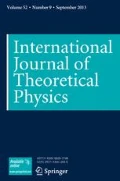Abstract
The conceptually non-trivial problem of relating the notion of a compound physical system and the mathematical descriptions of its constituent parts is dramatically illustrated in standard quantum physics by the use of the Hilbert tensor product of the spaces representing the subsystems, instead of the more familiar cartesian product, as it is the case for classical physical systems. Aspects of the general structure of this relationship can be explained by endowing suitable categories that arise in the mathematical descriptions of classical systems and of quantum systems with their natural monoidal structures, and constructing a monoidal functor, relating the monoidal structures of the domain and codomain categories in a coherent way. To highlight some of the structural aspects involved, I will confine myself in this paper to the simple case of finite sets or finite-dimensional Hilbert spaces, on which finite groups act.
Similar content being viewed by others
References
Abramsky, S., Coecke, B.: A categorical semantics of quantum protocols. Log. Comput. Sci. (2004). Also available at quant-ph/0402130
Aerts, D.: Description of many separated physical entities without the paradoxes encountered in quantum mechanics. Found. Phys. 12, 1131–1170 (1982)
Aerts, D., Daubechies, I.: Physical justification for using the tensor product to describe two quantum systems as one joint system. Helv. Phys. Acta 51, 661–675 (1978)
Borceux, F.: Handbook of Categorical Algebra. Volume 1: Basic Category Theory; Volume 2: Categories and Structures. Cambridge University Press, Cambridge (1994)
Foulis, D.J., Wilce, A.: Free extensions of group actions, induced representations, and the foundations of physics. In: Coecke, B., Moore, D., Wilce, A. (eds.) Current Research in Operational Quantum Logic, pp. 139–165. Kluwer Academic, Dordrecht (2000)
Gudder, S.P.: Representations of groups as automorphisms on orthomodular lattices and posets. Can. J. Math. 23, 659–673 (1971)
Gudder, S.P., Piron, C.: Observables and the field in quantum mechanics. J. Math. Phys. 12, 1583–1588 (1971)
Mackey, G.W.: Induced Representations of Groups and Quantum Mechanics. Benjamin, New York (1968)
Mac Lane, S.: Categories for the Working Mathematician. Springer, New York (1998)
Moore, D.: On state spaces and property lattices. Stud. Hist. Philos. Mod. Phys. 30, 61–83 (1999)
Piron, C.: Axiomatique quantique. Helv. Phys. Acta 37, 439–468 (1964)
Piron, C.: Foundations of Quantum Physics. Benjamin, Reading (1976)
Piron, C.: Mécanique Quantique. Bases et Applications. Presses Polytechniques et Universitaires Romandes, Lausanne (1990)
Author information
Authors and Affiliations
Corresponding author
Rights and permissions
About this article
Cite this article
Valckenborgh, F. Monoidal Categories, Symmetries, and Compound Physical Systems. Int J Theor Phys 47, 149–167 (2008). https://doi.org/10.1007/s10773-007-9547-3
Received:
Accepted:
Published:
Issue Date:
DOI: https://doi.org/10.1007/s10773-007-9547-3



